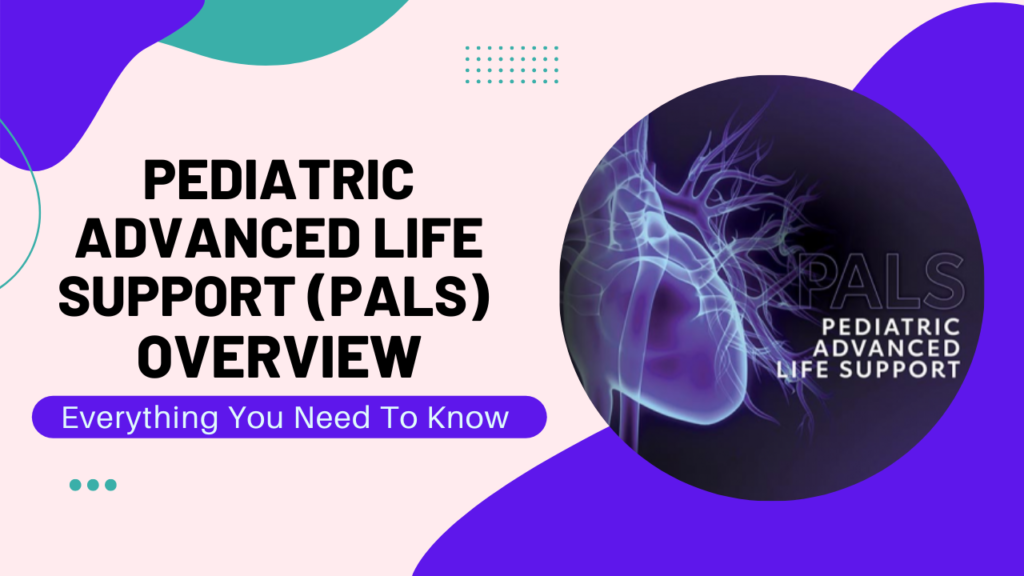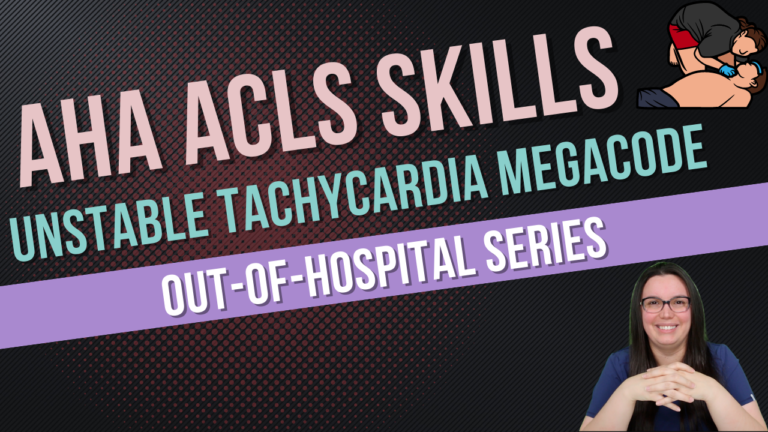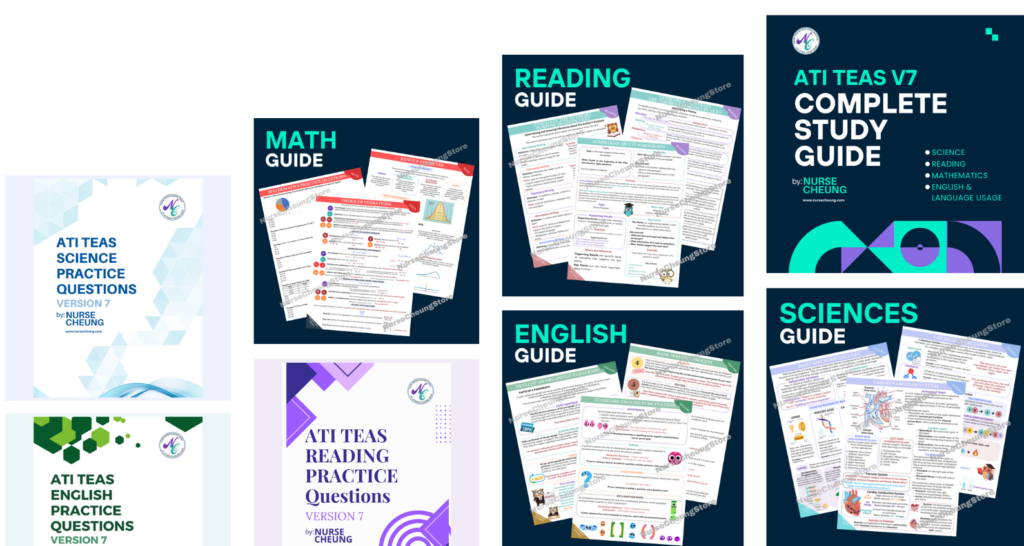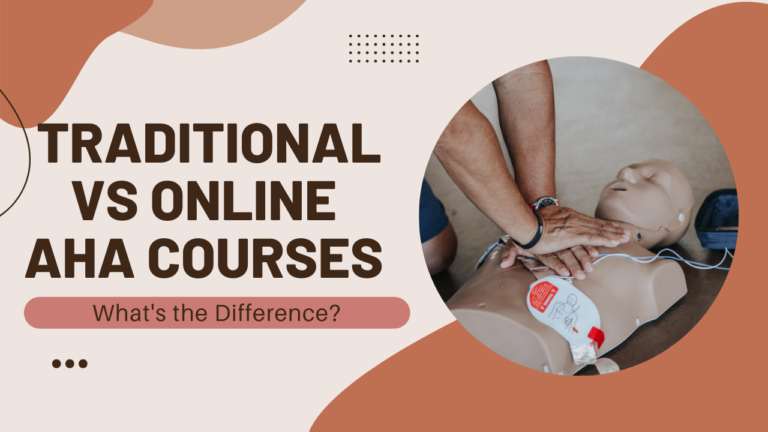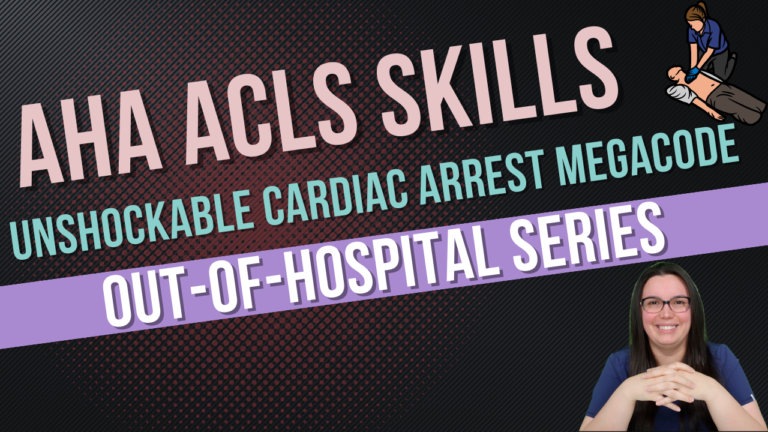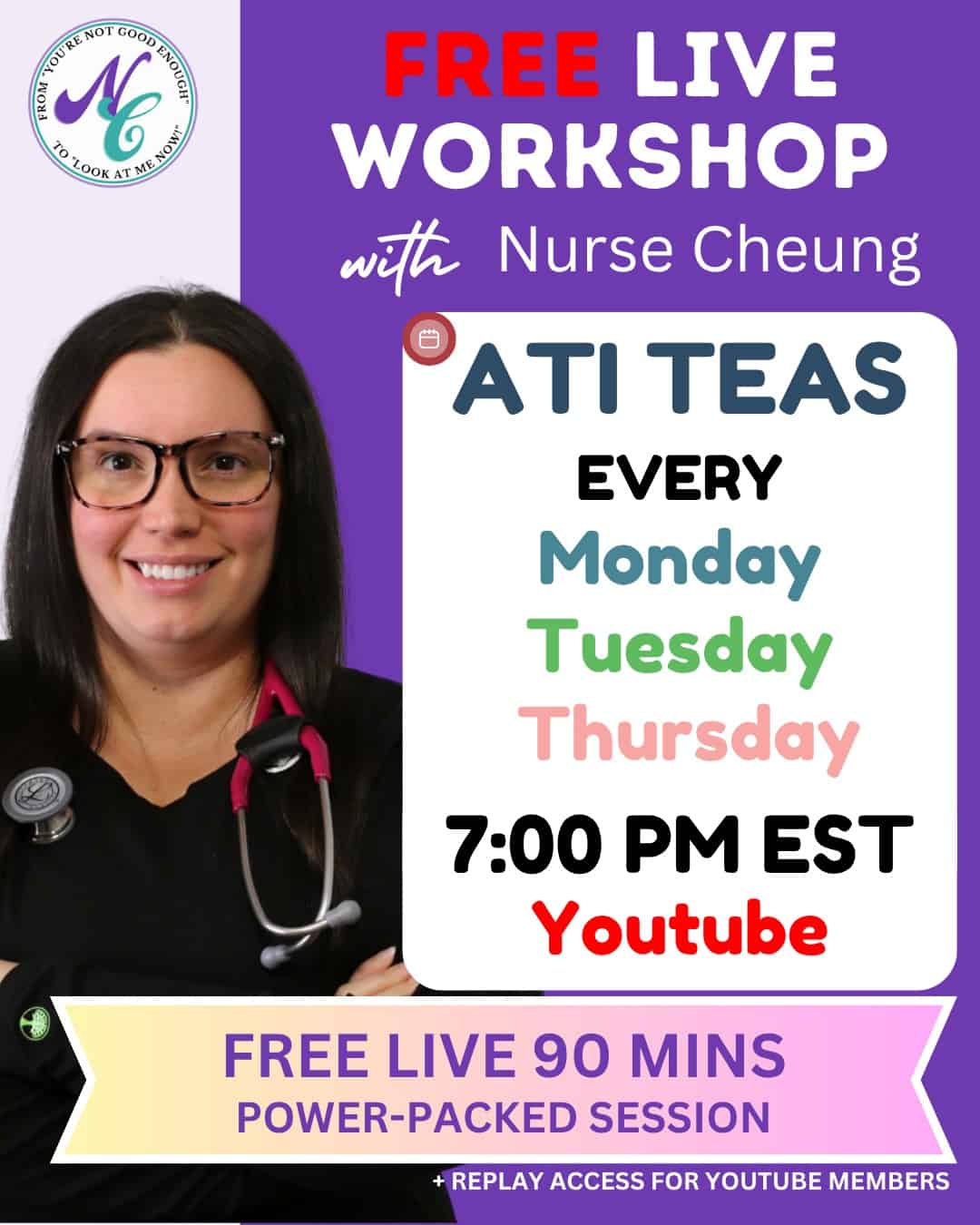If you are a healthcare professional who works with children, then you need to know about Pediatric Advanced Life Support (PALS).
PALS is a course that provides training in advanced life support for infants and children. It covers topics such as cardiac arrest, respiratory emergencies, shock, and more.
In this blog post, we will provide an overview of PALS and discuss everything that you need to know about it!
PALS History and Goals
The American Heart Association (AHA) created the PALS course in 1988 and is updated approximately every 5 five with the latest guidelines.
The goal of PALS is to improve the care of infants and children who are experiencing life-threatening events.
PALS is designed for healthcare professionals who work in:
- Emergency departments
- Intensive care units
- All pediatric care units and settings
- Pre-hospital settings (e.g., paramedics, EMTs)
Definition of Neonate, Infant, Child, and Adolescent in PALS
Neonate: A baby who is younger than 28 days old
Infant: A child who is between 29 days and 12 months old
Child: A child who is between 13 months and 12 years old (approximately age prior to puberty)
Adolescent: A teenager who is between 13 and 18 years old (when puberty is present either through armpit hair or breast development)
Basic Pediatric Life Support Guidelines
Pediatric Patient Assessment
The basic steps of Pediatric BLS are:
- Verify Scene Safety
- Check for responsiveness
- Call for help (Activate the Emergency Response System)
- Check for breathing and pulse
- Begin chest compressions
- Provide rescue breaths
- Continue chest compressions and rescue breaths until help arrives or the patient begins to breathe on their own.
Verify the scene is safe
Many times you may find that the scene may be unsafe with locations such as in the water, in the middle of the road, etc. If it is not safe, make the scene safe and move the person prior to starting interventions.
Check for Responsiveness
Tap the shoulders of a child or the heel of an infant and shout “Are you okay?”
If the patient does not respond, then they are unresponsive.
If the person does not respond, shout for nearby help and activate the emergency response system.
If no one responds, DO NOT LEAVE THE CHILD. Perform one round of CPR prior to finding help.
Activating the Emergency Response System
The first step in any emergency is to call for help.
You have two options
- If you have someone near you, have them get help and obtain an AED/Defibrillator
- If you are by yourself and have a mobile phone, call for emergency medical services and perform CPR.
Checking for Breathing and a Pulse
To check for breathing, look for the rise and fall of the chest.
To check for a pulse, the placement of your fingers will be dependent on the person’s age.
- Infant: palpate the brachial pulse
- Child: palpate the carotid or femoral pulse
These actions should be performed for a maximum of no more than 10 seconds.
If no breathing and pulse are present, immediately begin cardiopulmonary resuscitation (CPR).
Compressions, Airway, Breathing (CAB)
Chest Compressions Ratios, Placement, and Depth
For pediatric persons, there are three options for single-rescuer infant CPR.
30 chest compression: 2 breaths and 1 1/2 inches or 4cm in depth
- 2 fingers in the center of the infant’s chest, lower half of the breast bone
- 2 thumbs in the center of the infant’s chest, the lower half of the breastbone
- 1 hand in the center of the infants chest, lower half of the breastbone
Two-rescuer infant CPR
15 chest compressions: 2 breaths and 1 1/2 inches or 4cm in depth
- 2 thumbs in the center of the infant’s chest, the lower half of the breastbone
Children CPR Standards
30 chest compressions: 2 breaths and 2 inches or 5cm in depth
- 1 or 2 hand(s) in the center of the child’s chest, the lower half of the breast bone
Disclaimer regarding rescue breaths: According to guidelines posted by the American Heart Association on January 24, 2022, appropriate precautions should be worn when providing BLS, ACLS, and PALS standards with potential and confirmed COVID-19 positive patients. All providers should wear a respirator (i.e. N95), gown, gloves, and eye protection for suspected or confirmed COVID-19 infections when performing aerosol-generating procedures (AGP)s. Out of hospital cardiac arrest is dependent on early initiation of CPR including chest compression. It is not recommended for mouth-to-mouth resuscitation at this time but all patients should receive the best resuscitative efforts.
Chest Compression Rate
The compression rate should be 100-120 compressions per minute for infants, children, and adolescents.
You can keep track of the rate by counting out loud or using a metronome.
Allow for full chest recoil between compression and minimize interruptions to less than 10 seconds.
Be sure to switch compression team members every 2 minutes.
Airway And Breathing (CAB)
Utilize the sniffing position which requires flexion of the cervical spine and extension of the atlantooccipital joint.
Rescue breaths are one breath every 2 to 3 seconds regardless if there is an advanced airway present or not. You will want to see visible chest rise and fall within each rescue breath.
It is important to avoid excess ventilation because it can decrease coronary perfusion pressure and a reduction of cerebral blood flow causing PaCO2 to decrease.
How to use an AED/Defibrillator
When the AED arrives, review the instructions with the bystander.
Step One: Turn on the AED and follow the prompts.
Step Two: After removing the person’s shirt, apply the electrode pads to the patient’s bare chest in accordance with the instructions and plug in the connector. It is important to remove any wet barriers or medication patches before applying the pads.
- If the person is under 8 years old, use the child pads if available. If child pads are not available, you may use adult pads. Place pads so they do not touch each other. One pad is placed on the chest and the other pad is placed on the back. Pads should sandwich the heart when placed appropriately.
- If the person is 8 years old or older, use the adult pads. Do not use child pads as the shock will be too low of a dose.
Step Three: Stop chest compressions and confirm everyone is clear by saying “Stand Clear.”
Step Four: Push the analyze button and the AED will analyze the patient’s heart rhythm and, if needed, deliver a shock.
Step Five: if a shock is recommended, make sure no one is touching the person and repeat “Stand Clear.” Once clear, press the shock button.
Step Six: Immediately begin CPR following the shock or if no shock is advised. Perform another two minutes of CPR and follow the AED prompts again.
Agonal Breathing with a Pulse
If you see agonal breathing, it is still important to provide rescue breaths if there is a pulse present. Agonal breathing is an abnormal pattern of gasping and is not considered effective breathing.
Provide one rescue breath every 2 to 3 seconds with or without an advanced airway.
Bradycardic Rhythms in PALS
One of the most common bradycardic rhythms you may encounter in PALS is sinus bradycardia.
Sinus Bradycardia is defined as a heart rate of less than 60 bpm and the QRS complex is normal. The patient may or may not have symptoms.
Bradycardic Rhythm Interventions
Atropine
If symptomatic, the PALS guideline’s first drug of choice recommends atropine for bradycardia interventions. The initial dose is 0.02 mg/kg IV (maximum of 0.5 mg) and may be repeated once.
Important to note: Atropine can have a reverse effect in children causing cardiac arrest.
If the patient is unresponsive to atropine or has a high-degree heart block, you will need to place transcutaneous pacing pads.
Epinephrine
Epinephrine is an alternative drug choice for symptomatic bradycardia.
The recommended dose is 0.01 mg/kg IV/IO (0.1 mL/kg of the 0.1 mg/mL concentration) and can be repeated 3 to 5 minutes
- ET Dose: 0.1 mg/kg (0.1 mL/kg of the 1 mg/mL concentration)
Use epinephrine cautiously as raising blood pressures with an increase in heart rate can cause angina, myocardial ischemia, and increase oxygen demand.
For additional precautions, please reference an up-to-date drug guide.
Transcutaneous Pacing
Transcutaneous pacing is an external form of pacing that uses electrical current to stimulate the heart through the skin. This is considered a temporizing measure and is not a definitive treatment.
The pads are placed based on package instructions for pediatrics.
The unit will automatically deliver a pacing stimulus/demand rate at 60-100 bpm.
Pacer current (mA) output is also important as it determines the strength of the electrical impulse being delivered to the heart. The higher the number, the greater current being delivered which can cause burns if used for too long.
The recommended settings for an adult are:
-Pacing mode: demand
-Pacing rate: 60-100 bpm (can be set lower if the patient has a pre-existing tachycardia)
-Pacer output: 50-80 mA
Transcutaneous pacing should be continued until the patient’s condition improves, a transvenous pacemaker can be placed, or for no more than 45 minutes to avoid skin burns and patient discomfort.
Transcutaneous Precautions
Conscious paced patients may require additional analgesics for pacing discomfort. Also, you will want to avoid palpating the carotid pulses to confirm capture as the electric impulses cause muscle jerking that may mimic a pulse.
Trachycardic Rhythms in PALS
Two of the most common tachycardic rhythms you may encounter in PALS include supraventricular tachycardia and ventricular tachycardia with a pulse.
Supraventricular Tachycardia is defined as tachycardia that originates from above the ventricles in the atria or AV node.
Ventricular Tachycardia is defined as tachycardia that originates from the ventricles. This rhythm can become lethal if left untreated.
Tachycardic Rhythm Interventions
Vagal Maneuvers
Vagal maneuvers are a physical intervention used to decrease the heart rate by stimulating the vagus nerve.
The most common maneuver is the Valsalva maneuver which is performed by having the person:
- Take a deep breath in
- Attempt to exhale by bearing down or blowing through an occluded 10mL syringe for 15 to 20 seconds
This should result in a decrease in heart rate by decreasing the conduction of electrical impulses through the AV node.
Additional vagal techniques include coughing, a cold stimulus to the face, carotid massage, and gagging.
Adenosine
If unsuccessful vagal maneuvers are unsuccessful, the next step is to administer adenosine.
Adenosine is a medication that works by decreasing the conduction of electrical impulses through the AV node.
The recommended initial dose is 0.1 mg/kg given as a rapid IV push followed by a 10-20 mL saline flush (maximum dose 6mg). It also helps to elevate the extremity after administration.
The recommended second dose is 0.2 mg/kg given as a rapid IV push followed by a 20 mL saline flush (maximum dose 12mg).
Synchronized Cardioversion
If the patient remains unstable or unresponsive to previous interventions, synchronized cardioversion may be necessary.
Cardioversion is a procedure that uses electrical shocks to reset the heart’s electrical impulses and rhythm.
It is important to note that this should only be done when the person is unstable or unresponsive as it can be a painful and traumatic experience for the person.
Initial recommended voltage doses
- 0.5 to 1 joule/kg
- If the initial dose is not effective, increase to 2 joules/kg
Synchronized Cardioversion Procedure
- Obtain a 12-Lead ECG if the patient is stable
- Prepare proper sedation since cardioversion is painful and have emergency equipment ready in case of complications
- Place defibrillator pads on the person and set the monitor to synchronized (sync) mode. Engage the synch mode before each attempt.
- Look for sync markers above each R wave.
- Set your dose of electricity/voltage
- Clear all personnel from the patient prior to the shock
- Press the “charge” button, “clear” the patient, and press the “shock” button
- Reassess the patient after each shock
PALS Shockable Rhythms
There are two shockable rhythms in the AHA PALS guidelines that you may encounter in PALS: pulseless ventricular tachycardia and ventricular fibrillation.
Pulseless Ventricular Tachycardia is defined as a wide complex tachycardia with a heart rate of >100 bpm in the absence of a pulse.
Ventricular Fibrillation is defined as a rapid, erratic, and chaotic electrical activity in the ventricles that results in the loss of coordinated contractions.
PALS Shockable Rhythm Interventions
Cardiopulmonary Resuscitation
Cardiopulmonary Resuscitation (CPR) is the first line of defense for both of these rhythms as it provides oxygen to the heart and brain.
Review the Basic Life Support Guidelines for CPR here
Defibrillation
Defibrillation is the use of electrical shocks to reset the heart’s electrical impulses and rhythm without syncing to the person’s intrinsic rhythm.
The recommended dose of electricity
- Initial Dose: 2 Joules/kg
- Second Dose: 4 Joules/kg
- Subsequent Dose: > or = to 4 Joules/kg
- Maximum Dose: 10 Joules/Kg
- Remember the mnemonic: 2, 4, 6, 8 – That’s the dose we defibrillate.
Defibrillation Procedure
- Turn on the defibrillator and set the joules based on the machine used
- Place adhesive pads on the person based on the pad’s package instructions
- Announce to the team “Charging defibrillator” and press the charge button
- When the defibrillator is fully charged, verify all team members are clear by announcing the shock. Once the team announces all clear and you have verified the team is not touching the person or bed, call “All Clear!”
- Press the shock button on the defibrillator
- Immediately after shock is delivered, resume CPR for 5 cycles (2 minutes) then reassess rhythm
Epinephrine
Epinephrine is a drug choice for cardiac arrest interventions.
The recommended dose is 0.01 mg/kg IV/IO (0.1 mL/kg of the 0.1 mg/mL concentration) and can be repeated 3 to 5 minutes
- ET Dose: 0.1 mg/kg (0.1 mL/kg of the 1 mg/mL concentration)
Use epinephrine cautiously as raising blood pressures with an increase in heart rate can cause angina, myocardial ischemia, and increase oxygen demand.
For additional precautions, please reference an up-to-date drug guide.
Amiodarone
Amiodarone is a medication that is used to slow the heart rate and improve cardiac output.
The recommended initial dose is 5 mg/kg IV or IO bolus.
The dose may be repeated up to 3 total doses for refractory ventricular fibrillation and pulseless ventricular tachycardia.
Lidocaine
Lidocaine is a medication that is used to treat ventricular arrhythmias and is considered immediately after the return of spontaneous circulation (ROSC).
The recommended initial dose during active CPR is 1 mg/kg IV or IO loading dose.
PALS Non-Shockable Rhythms
There are two non-shockable rhythms in the AHA PALS guidelines that you may encounter in PALS: asystole and pulseless electrical activity.
Asystole is defined as a heart rhythm that is not amenable to defibrillation also known as a flat line.
Pulseless Electrical Activity (PEA) is defined as electrical activity on the monitor but no mechanical activity.
PALS Non-Shockable Rhythm Interventions
Cardiopulmonary Resuscitation
Cardiopulmonary Resuscitation (CPR) is the first line of defense for both of these rhythms as it provides oxygen to the heart and brain.
Review the Basic Life Support Guidelines for CPR here
Ephinephrine
Epinephrine is a drug choice for cardiac arrest interventions.
The recommended dose is 0.01 mg/kg IV/IO (0.1 mL/kg of the 0.1 mg/mL concentration) and can be repeated 3 to 5 minutes
- ET Dose: 0.1 mg/kg (0.1 mL/kg of the 1 mg/mL concentration)
Use epinephrine cautiously as raising blood pressures with an increase in heart rate can cause angina, myocardial ischemia, and increase oxygen demand.
For additional precautions, please reference an up-to-date drug guide.
Consider your H and T causes
It is important to consider your H’s and T’s for these rhythms and treat accordingly.
H’s and T’s are mnemonics for the major causes of arrest:
- Hypovolemia
- Hypoxia
- Hydrogen ions (acidosis)
- Hyperkalemia or hypokalemia
- Hypothermia
- Hypoglycemia
- Tamponade (cardiac, tension)
- Toxins
- Tension pneumothorax
- Thrombosis (coronary, pulmonary)
PALS Post Cardiac Arrest / Return of Spontaneous Circulation (ROSC)
Once the person has been successfully resuscitated, it is important to focus on post-arrest care.
This includes oxygenation and ventilation, hemodynamic monitoring, targeted temperature management, neuromonitoring, electrolytes and glucose, sedation, and prognosis.
Oxygenation and Ventilation
The first and most important intervention for any person with ROSC is to ensure they are adequately oxygenated and ventilated.
Be sure to monitor the patient’s oxygen saturation for any changes in condition or fluctuation that may require supplemental oxygen.
Hemodynamic Monitoring
It is important to monitor the patient’s hemodynamic status as this will give you insight into their cardiac output and tissue perfusion.
This includes cardiac telemetry, arterial blood pressure, and blood collection lactate and urine output.
Targeted Temperature Management / Brain Management
- Targeted Temperature Management is the current standard of care for comatose post-cardiac arrest patients.
- The AHA recommends a target temperature of 33 degrees Celsius for 24 hours be used in comatose patients.
Neuromonitoring
Neuromonitoring is important in post-arrest care as it can help to identify any neurological changes that may occur.
This includes continuous electroencephalogram, treating seizures, and brain imaging.
Electrolytes and Glucose
It is important to monitor the patient’s electrolytes and glucose levels as they can be easily disturbed in post-arrest care.
Be sure to monitor potassium, calcium, magnesium, phosphorus, and glucose levels.
Sedation
Sedation is often necessary for post-arrest care to ensure the person is comfortable and to prevent further neurological injury.
Prognosis
The final step in post-arrest care is to assess the person’s prognosis.
This includes looking at the person’s age, comorbidities, arrest factors, and response to treatment.
Pediatric Respiratory Emergencies
Upper Airway Obstructions
The most common cause of upper airway obstruction in children is the tongue.
Other causes include foreign bodies, such as food or toys, croup, anaphylaxis, and enlarged tonsils or adenoids.
The signs and symptoms of upper airway obstruction include stridor – hallmark sign, barking cough, hoarseness, drooling, snoring, gurgling, increased work of breathing, retractions, and cyanosis.
The first step in the management of upper airway obstruction is to ensure the child has a patent airway.
If the child is not able to maintain their own airway, they will need to be intubated.
The next step is to treat the underlying cause of the obstruction.
This may include removing a foreign body, administering medication for croup or anaphylaxis, or managing enlarged tonsils or adenoids.
Lower Airway Obstructions
The most common cause of lower airway obstruction in children is bronchiolitis.
Other causes include asthma, foreign body aspiration, and pneumonia.
The signs and symptoms of lower airway obstruction include expiratory wheezing/prolonged expiratory phase – hallmark sign, and increased work of breathing.
The first step in the management of lower airway obstruction is to ensure the child has a patent airway.
If the child is not able to maintain their own airway, they will need to be intubated.
The next step is to treat the underlying cause of the obstruction.
This may include administering medication for asthma or bronchiolitis, removing a foreign body, or treating pneumonia.
Lung Tissue Disease
Lung tissue disease is defined as any disease that affects the structure or function of the lungs. The lungs become stiff due to fluid accumulation in the alveoli, interstitium, or both.
The most common cause of lung tissue disease in children is pneumonia.
Other causes include pulmonary edema, pneumonitis, and acute respiratory distress syndrome (ARDS).
The signs and symptoms of lung tissue disease include increased work of breathing, tachypnea, crackles, grunting, and decreased breath sounds.
You will begin by treating the underlying cause of the obstruction.
This may include administering antibiotics for pneumonia, diuretics for pulmonary edema, or corticosteroids for pneumonitis.
Disorder Control of Breathing
Disordered control of breathing is defined as any disorder that affects the ability to control the depth or rate of breathing. This can include neurological disorders.
Other causes include metabolic abnormalities, drug overdoses, and poisoning.
The signs and symptoms of disordered control of breathing include variable/decreased respiratory rate and effort with normal breath sounds.
You will begin by treating the underlying cause of the disorder.
This may include avoiding hypoxemia/hypercarbia/hyperthermia for a neurological disorder, giving antidotes for poisoning or overdose, and ventilatory support for neuromuscular disease.
Intubation of Pediatric Persons
The process of intubation involves passing a tube through the mouth and into the trachea.
This is done in order to provide a patent airway and to allow for mechanical ventilation.
While the process of intubation is not covered, the complications that may occur are. Sudden deterioration in an intubated person can be detected during the DOPE mnemonic (displacement of the tube, obstruction of the tube, pneumothorax, and equipment failure).
Displacement of the Tube
The most common complication of intubation is the displacement of the tube (specifically displaced in the right bronchus).
This can occur due to coughing, vomiting, or suctioning.
If the tube is displaced, it will no longer be in the trachea and will need to be replaced.
Obstruction of the Tube
The second most common complication of intubation is obstruction of the tube.
This can occur due to secretions, mucus, blood, or vomit.
If the tube is obstructed, it will need to be suctioned.
Pneumothorax
Pneumothorax is a complication that can occur if the tube is placed too deeply in the trachea.
This can cause the lung to collapse.
There are two types of pneumothoraces: simple and tension.
- Simple pneumothorax is when the lung collapses but there is no tension on the heart. Sudden deterioration in oxygen, decreased chest expansion, and loss of breath sounds on the involved side can be noted.
- Tension pneumothorax is when the lung collapses and there is tension on the heart. Sudden deterioration is evident by hypotension and a decrease in cardiac output.
If a pneumothorax occurs, the tube will need to be removed and the person will need to be treated for the pneumothorax via a chest tube.
Equipment Failure
The final complication of intubation is equipment failure.
This can occur due to a number of reasons such as power failure, malfunctioning equipment, or human error.
If equipment fails, it will need to be replaced.
AHA PALS Shock Emergencies
Shock is a condition in which the body is not getting enough blood flow.
This can be due to a number of reasons such as cardiac arrest, anaphylaxis, or trauma.
There are four kinds of shock: hypovolemia, cardiogenic, distributive, and obstructive shock.
Hypovolemic Shock
Hypovolemic shock is when there is a decrease in blood volume.
This can be due to blood loss, dehydration, or third spacing.
The signs and symptoms of hypovolemic shock include tachycardia, hypotension, and decreased urine output.
The treatment for hypovolemic shock is to replace the fluid that has been lost.
This can be done via IV fluids or blood transfusion.
Cardiogenic Shock
Cardiogenic shock is when the heart is unable to pump enough blood to meet the body’s needs.
This can be due to myocardial infarction, cardiac tamponade, congenital heart disease, myocarditis, cardiomyopathy, or pulmonary embolism.
The signs and symptoms of cardiogenic shock include tachycardia, bradyarrhythmia, hypotension, and decreased cardiac output.
The treatment for cardiogenic shock is to support the heart and to treat the underlying cause.
This can be done via IV fluids, inotropes, and mechanical support.
Distributive Shock
Distributive shock is when there is a decrease in perfusion to the tissues.
This can be due to sepsis, anaphylaxis, neurogenic shock, or spinal cord injury.
The signs and symptoms of distributive shock include tachycardia, hypotension, and decreased urine output.
The treatment for distributive shock is to treat the underlying cause.
This can be done via IV fluids, antibiotics, antihistamines, epinephrine, and vasopressors.
Obstructive Shock
Obstructive shock is when there is an obstruction in the blood flow.
This can be due to tension pneumothorax, cardiac tamponade, ductal-dependent left ventricle obstruction, pulmonary embolism, or thrombosis.
The signs and symptoms of obstructive shock include tachycardia, bradyarrhythmia, hypotension, and decreased cardiac output.
The treatment for obstructive shock is to treat the underlying cause.
This can be done via an IV fluid, chest tube, pericardiocentesis, needle decompression, thrombolytic, or surgery.
AHA PALS Systematic Approach for Megacode
The systematic approach for megacode can help identify a potentially life-threatening emergency through the use of identifying, intervening, and evaluating.
Initial Impression (A, B, C)
The first step is to identify the person and the problem. This is done by assessing the person’s initial impression through appearance, breathing, and circulation.
Appearance
The person’s appearance includes the level of consciousness and ability to interact.
This can be done by using the Glasgow Coma Scale.
Breathing
The person’s breathing includes the rate, depth, and quality of breathing.
This can be done by observing the person’s chest rise and fall and listening for any audible breath sounds including wheezing, grunting, and stridor.
Circulation
The person’s circulation includes the skin color and condition.
This can be done by noting any pallor, petechiae, bleeding, and/or wounds.
Primary Assessment Survey (A, B, C, D, E)
The PALS Primary Survey is ABCDE (Airway, Breathing, Circulation, Disability, and Exposure).
Airway
The airway should be assessed for patency and the presence of foreign bodies.
- Maintain airway patency in unconscious patients
- Is there good flow in the trachea? The cricoid cartilage is the narrowest point in a pediatric airway. The pediatric head, tongue, and epiglottis are larger than those of adults.
- Use advanced airway if needed
- Confirm CPR/Ventilation/Secure Device
- Monitor Airway Placement with continuous quantitative waveform capnography
Breathing
The breathing should be assessed for the quality of breathing
- Is the respiratory rate regular, increased, or decreased? Is breathing effort unlabored? Is the chest expanding appropriately? Are there any adventitious breath sounds?
- Give supplementary oxygen as needed
- 100% oxygen for cardiac arrest patients
- Titrate oxygen for stable patients
- Avoid excessive ventilation
- IMPORTANT: AGONAL GASPS ARE NOT NORMAL (FIRST SIGNS OF IMPENDING CARDIAC ARREST). START CPR IMMEDIATELY.
Circulation
The circulation should be assessed for blood pressure, heart rate, and pulse quality.
- Is the heart rate regular, increased, or decreased? Heart rate greater than 180/min in an infant or toddler and 160/min in a child older than two years old warrants assessment.
- Is the heart rhythm regular or irregular?
- Pulses equal both peripherally and centrally
- Is the blood pressure hypotensive or hypertensive? Low systolic blood pressure is a late sign that something is wrong. Low systolic blood pressure is less than 70 + 2x(Age of Years of Child). Exceptions: neonates <60, infants <70, children ages 10 and older <90.
- Skin color and temperature
- Capillary refill
Disability
The disability should be assessed for the level of consciousness and the presence of seizures.
- Check for neurological function – level of consciousness, pupillary responsiveness
- AVPU – Alert, Verbal stimulation, Painful stimulation, Unresponsive
- Monitor blood glucose – neonate <45, infant/child < or = 60
Exposure
The exposure should be assessed for the presence of signs and symptoms of injuries.
- Body temperature
- Remove clothing: Assess for obvious signs of trauma, bleeding, burns, markings, medical alert bracelet
PALS Secondary Survey (SAMPLE)
The PALS Secondary Survey is SAMPLE (signs and symptoms; allergies; medications, past medical history; last meal, liquid consumed; and events).
Signs and Symptoms
The signs and symptoms should be assessed for the presence of any changes.
- Objective information of what we see
- Subjective information from family or the ambulance
Allergies
The allergies should be assessed for any food, medication, or environmental causes.
Medications
The medications should be assessed for any medication causes.
- Over the counter medications
- Vitamins
- Supplements
- Prescribed Medications
- Any medications not prescribed that may have been ingested or used
Past Medical History
The past medical history should be assessed pre-existing conditions.
- Medical conditions
- Surgical history
- Previous hospitalizations
- Clinical procedures
- Immunizations up to date
Last Meal, Liquid, Pee, Poop
The last meal or liquid consumed should be assessed for the time of the last meal or drink.
- Time of last meal
- Type of food or drink consumed
The last pee or poop should be assessed
- When was the last pee, poop, or wet diaper?
- How much was it?
Events
The events should be assessed for any changes that lead up to the current presentation.
- Headache
- Dizziness
- Nausea/vomiting
- Visual changes
- Sudden onset of symptoms (e.g., slurred speech)


